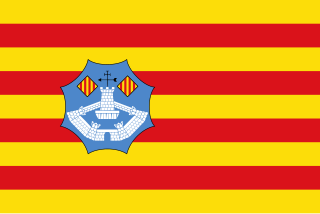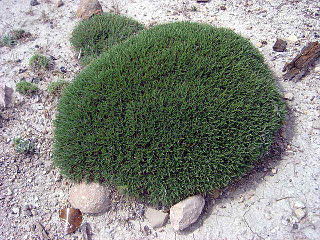Gunderic, King of Hasding Vandals (407-418), then King of Vandals and Alans (418–428), led the Hasding Vandals, a Germanic tribe originally residing near the Oder River, to take part in the barbarian invasions of the Western Roman Empire in the fifth century.

Mallorca, or Majorca, is the largest island of the Balearic Islands, which are part of Spain, and the seventh largest island in the Mediterranean Sea.

Menorca or Minorca is one of the Balearic Islands located in the Mediterranean Sea belonging to Spain. Its name derives from its size, contrasting it with nearby Mallorca. Its capital is Mahón, situated on the island's eastern end, although Menorca is not a province and forms a political union with the other islands in the archipelago. Ciutadella and Mahón are the main ports and largest towns. The port of Mahón is the second biggest natural port in the world.
Year 123 BC was a year of the pre-Julian Roman calendar. At the time it was known as the Year of the Consulship of Balearicus and Flamininus and the Sixth Year of Yuanshuo. The denomination 123 BC for this year has been used since the early medieval period, when the Anno Domini calendar era became the prevalent method in Europe for naming years.

Hispania Tarraconensis was one of three Roman provinces in Hispania. It encompassed much of the northern, eastern and central territories of modern Spain along with modern northern Portugal. Southern Spain, the region now called Andalusia, was the province of Hispania Baetica. On the Atlantic west lay the province of Lusitania, partially coincident with modern-day Portugal.

Alcúdia (Catalan pronunciation:[əlˈkuðiə]) is a municipality and township of the Spanish autonomous community of the Balearic Islands. It is the main tourist centre in the North of Majorca on the eastern coast. It is a large resort popular with tourists. Most of the hotels are located in Port d'Alcúdia and Platja d'Alcúdia, along the 14 km-long (8.7 mi) beach that stretches all the way to Ca'n Picafort. In Alcúdia, the old town is well preserved with houses dating back to the 13th century. The old town is surrounded by a medieval wall.

This is a historical timeline of Portugal.
The Sertorian War was a civil war fought from 80 to 72 BC between a faction of Roman rebels (Sertorians) and the government in Rome (Sullans). The war was fought on the Iberian Peninsula and was one of the Roman civil wars of the first century BC. The Sertorians, a coalition of Celts, Aquitanians, Iberians and Roman and Italic rebels, fought against the representatives of the regime established by Sulla. The war takes its name from Quintus Sertorius, the leader of the opposition. It was notable for Sertorius' successful use of guerrilla warfare. The war ended after Sertorius was assassinated by Marcus Perperna, who was then promptly defeated by Pompey.
Quintus Caecilius Metellus Balearicus was a Roman statesman and general who was elected consul for the year 123 BC.
Gaius Caecilius Metellus Caprarius was a consul of the Roman Republic in 113 BC with Gnaeus Papirius Carbo. He served under Scipio Aemilianus in Numantia around 133 BC. He was praetor in 117 BC. His proconsulship in Thrace in 112–111 BC earned him a triumph. He was censor in 102 BC with his cousin, Quintus Caecilius Metellus Numidicus.

Hispania was the Roman name for the Iberian Peninsula and its provinces. Under the Roman Republic, Hispania was divided into two provinces: Hispania Citerior and Hispania Ulterior. During the Principate, Hispania Ulterior was divided into two new provinces, Baetica and Lusitania, while Hispania Citerior was renamed Hispania Tarraconensis. Subsequently, the western part of Tarraconensis was split off, initially as Hispania Nova, which was later renamed "Callaecia". From Diocletian's Tetrarchy onwards, the south of the remainder of Tarraconensis was again split off as Carthaginensis, and all of the mainland Hispanic provinces, along with the Balearic Islands and the North African province of Mauretania Tingitana, were later grouped into a civil diocese headed by a vicarius. The name Hispania was also used in the period of Visigothic rule.

The Balearic Islands are an archipelago in the western Mediterranean Sea, near the eastern coast of the Iberian Peninsula. The archipelago conforms a province and autonomous community of Spain, with Palma de Mallorca being its capital and largest city.

Sanisera was one of the Roman cities located in the island of Menorca, which was mentioned by Pliny the Elder in his book Naturalis Historia, III, 77–78 in the 1st century BC:
The Baleares, so formidable in war with their slingers, have received from the Greeks the name of Gymnasiæ. The larger island is 100 miles in length, and 475 in circumference. It has the following towns; Palma and Pollentia, enjoying the rights of Roman citizens, Cinium and Tucis, with Latin rights; and Bocchorum was a federate town. At thirty miles' distance is the smaller island, 40 miles in length, and 150 in circumference; it contains the states of Jamnon, Sanisera, and Magon.
This section of the timeline of Hispania concerns Spanish and Portuguese history events from the Carthaginian conquests to before the barbarian invasions.

The Battle of the Nervasos Mountains occurred in the year 419 and was fought between a coalition of Suebi, led by King Hermeric together with allied Roman Imperial forces stationed in the Province of Hispania, against the combined forces of the Vandals and Alans who were led by their King Gunderic. This battle occurred in the context of a contemporary Germanic invasion of the Iberian Peninsula. The battle took place in what is today the Province of León, Spain, and resulted in a Roman/Suebian Victory.
Bocchoris was an ancient city in northern Majorca, dating back to pre-Roman times. It was one of the oldest settlements in Majorca and was once a foederatus, as recorded by Pliny the Elder.

Pollentia was a Roman city founded by Quintus Caecilius Metellus Balearicus in the present city of Alcúdia, allegedly in the year 123 BC.

The Diocese of Hispania was a late antique administrative unit (Dioecesis) of the Roman Empire on the Iberian Peninsula. It existed from 314 to about 409 AD. Its capital was Augusta Emerita. The diocese was governed by a vicarius responsible to the praetorian prefect of Gaul.

Astragalus balearicus, commonly known as the Balearic milkvetch or gatovell, is a small legume of the genus Astragalus that is found on the Balearic Islands off the coast of Spain.













